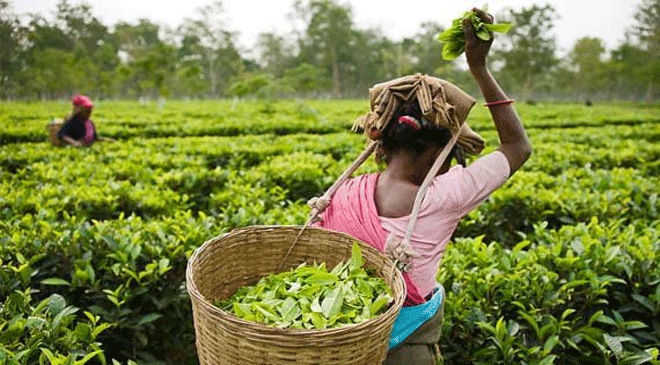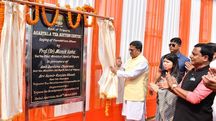The real 'Tea Story': Crisis brews in the plantations
 Image for representation
Image for representationThe covid19 pandemic is anything but just a global public health crisis. The collateral multidimensional socio-economic ruin and the implications on mental health can only be assessed in its entirety once the dust has settled around it. With a vaccine nowhere on the horizon coupled with the precarious position of the economy, the workers employed in the lowest levels of informal and formal sectors have been the worst affected on all fronts. The myopia of the present dispensation has only compounded to their plight.
The pandemic has exposed a lot of things in the sub-continent about the status quo that we were getting so comfortable with. These prevailing fault lines of the dilapidated and dehumanising public health machinery which lie in shambles have been entirely laid bare and public consciousness around it has rekindled with pictures of millions of migrant workers walking thousands of kilometres to get to their homes being circulated across the internet. This migrant crisis is one of the worst ever in the history of India if not the world.
A dive back to where it started in Assam
Let's head back to a migratory event that took place in a different space and time. On the battered backs of many a migrant an industry took birth in Assam two centuries ago. This labour migration was induced by using various unscrupulous coercive policies devoid of any iota of humanity and continued well into the 20th Century. With the help of their cheap labour the tea industry was set up and consolidated by the colonisers. The Britishers found that the local population was unwilling, unfit, and insufficient to meet their workforce needs. Hence, the requisite labour was brought in from the tribal belts of central India initially with the promise of much better prospects and subsequently, once their bluff was called, they started employing outright coercive measures. Simultaneously another migration was taking place of Bengali Muslim peasants from what is now Bangladesh. The sheer scale of these two events can be better put into perspective if one considers that the growth of the population in Assam was a staggering 138 percent from 1901 to 1951 while the pan India average was 52 percent. The migrants working in the tea plantations invariably found themselves trapped in a timeless and isolated system that still persists with institutional sanctions.
Also read: Assam: Tea industry suffers uncertainties amid 500-cr loss under lockdown
Fast Forward
The present-day tea industry continues to relegate the Adivasi population that has worked in these plantations through generations to sub-human conditions. The management and influential higher-ups cry crisis and unflinchingly attempt to justify the payment of below minimum daily wages. It is set at Rs 167 and 145 for the plantations in the Brahmaputra Valley and the Barak Valley respectively. The state prescribed minimum wage is 272.02. In their defence, there does exist a non-cash component to the wages whereby the plantations are obligated to ensure delivery of social welfare like health care, ration, education, housing, and such. It should be kept in mind that these so-called benefits are not doles paid out to the labourers, but are serviced from wages that rightfully belong to them.
The quality of these services is deplorable to say the least. Leaky roofs, inedible ration, dilapidated health infrastructure, schools with no teachers are conditions that are quite rife. The paltry wage and the poor service delivery are nothing short of wage theft that has persisted through generations.
Exposing the vulnerabilities
One might wonder how the issues of migration, scanty wage, and poor public infrastructure are of any consequence in a pandemic that, of course, no one saw coming. The all-encompassing inadequacy of the cash and non-cash components has forced these workers at the very bottom of the socio-economic pyramid to the throes of poverty for generations. The dependency on poor services has left a predominantly female workforce anemic and malnourished. Coupled with the lack of access to even basic healthcare, which is usually chronically understaffed and spatially inaccessible, and other amenities these factors have combined to push the maternal mortality and infant mortality rates very high. The men, who usually take charge of what is seen to be the more “masculine” roles like pruning, weeding, and spraying of pesticides are exposed to lethal chemicals in the absence of protective gear and non-adherence to safety norms, suffer from ailments like tuberculosis, lung complications and loss of vision. These are all preventable conditions.
The Corona Dynamic
Enter covid19 along with the subsequent lockdown and the tea plantations fall into jeopardy. This lockdown coincided with the first flush of the harvest which is the most prized, yielding the maximum revenue for the plantations. The revenue from this flush, which is form mid February to early April accounts for as much as 35-40 per cent of the total revenue generated in one plantation cycle of four flushes. The inability to pluck the produce owing to the lockdown resulted in overgrowth in the plants. This phenomenon renders the leaves un-processable. This overgrowth requires to be rid off by employing a process called skiffing. Moreover, the plants require around two to three weeks to be restored to pluckable condition. This effectively means that the productivity of second flush will also be impacted.
The estimated loss for the industry in Assam has been put at Rupees 1,218 crore. These losses have doubled down on the plight of the labourers as the abysmally low wages have been sporadically paid during this period. With paltry or no savings their cash requirements could not be met to buy basic essentials resulting in hunger which in turn takes a toll on immunity. However, with sustained lobbying from the industry about the astronomical losses that they will face if the lockdown is enforced in equal intensity inside the plantations the government of Assam caved in to allow resumption of activity at 50 per cent capacity from 10th of April. In the subsequent relaxations they have been exempted from any restriction with the guarantee that all precautionary measures would be followed. As a result, the labourers, destitute and desperate, have resumed work.
Add to these factors the prevailing conditions in the labour lines of these plantations - low maintenance, crammed up quarters, high occupant density and you have the perfect recipe of an impending disaster. With covid19 exhibiting a higher mortality rate amongst patients with co-morbidities, the widespread prevalence of pre-existing ailments amongst the labourers provides us with a grim reality. Further, the sorry state of health infrastructures within the impervious walls of the timeless plantations even in the time of “normalcy” only makes one hope that adequate measures are being taken to tackle this crisis. If the historical apathy of the industry and the government towards the tea plantation labourers is anything to go by then the ground reality looks very grim.
Going forward
The priority of all the stakeholders needs an overhaul to put the interests of the most vulnerable on the top rung. There is absolutely no contesting the fact that the tea industry is incurring massive losses, the government is dealing with an unforeseen situation and the sinking economy needs to be steadied. But the tendency to further loosen labour laws for a workforce that is already grossly underpaid and overworked cannot under any circumstances be a way forward. Still, various questions remains unanswered as of now. What costs are we willing to pay to restart the economy, what will be the magnitude and who will bear the disproportionate share of these costs? The answer is clearly not the industrial higher-ups or the government.
ABOUT THE AUTHOR: Kallol Deka is a post-graduate student of Labor Studies and Social Protection, Tata Institute of Social Sciences, Guwahati. His interest areas are Labour and Human rights, Politics, Society, Environmental Conservation.
The views of the article are that of the writer.
Readers like you make Inside Northeast’s work possible.
To support our brand of fearless and investigative journalism, support us HERE.
Download:
The Inside Northeast app HERE for News, Views, and Reviews from Northeast India.
Do keep following us for news on-the-go. We deliver the Northeast.
Copyright©2025 Living Media India Limited. For reprint rights: Syndications Today









